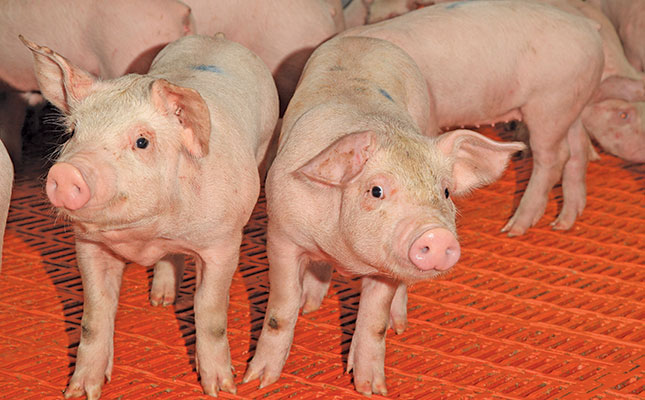

While growing concern over animal welfare is sparking changes in the way pigs are produced internationally, production costs remain a main driver of improved welfare on pig farms.
“The cost of production is so high that farmers cannot afford to neglect their animals. They know that stressed pigs will be less resilient, more disease-prone, take longer to finish and be less productive than stress-free animals.”
Food and water
Farmers generally understand the importance of giving their animals access to enough clean, potable water and a balanced ration of food, but we still see some cases of malnutrition on smallholder or backyard farms, where farmers don’t have the financial means to buy premixed formulations. It pays to invest in good-quality food, as malnutrition can lead to all kinds of problems, ranging from poor growth and reproductive problems to birth complications and death.
In some cases, the pigs simply do not receive enough feed, whereas they might be suffering from specific nutritional deficiencies if the rations are unbalanced. Farmers, for instance, might be feeding their pigs bread waste and maize, which are high in energy, but low in protein. A protein deficiency may lead to poor growth and feed conversion, as well as fatter carcasses in growing and finishing pigs, while affecting milk production negatively and delaying oestrus in lactating sows.
Calcium and phosphorus deficiencies, meanwhile, may result in rickets or osteomalacia, a condition that causes the bones to become soft and weak. Sows that produce high levels of milk and large litters may also develop posterior paralysis towards the end of lactation due to calcium or phosphorus deficiencies.
To avoid such deficiencies, farmers should speak to their local animal health technician or nutritionist, veterinarian, extension officer or co-operative to help them formulate a diet based on available resources. Food scraps are another concern. The food should be free from toxins, chemicals and pathogens, as well as particles that might injure the pigs.
In general, fruit and vegetable waste can be fed to pigs without much concern, but scraps that contain meat should be boiled for at least an hour to destroy diseases like foot-and-mouth disease (FMD) and African swine fever (ASF). FMD and ASF are highly contagious diseases associated with high mortality rates. Outbreaks have to be reported to prevent the diseases from spreading to other farms.
Creature comforts
The use of climate-controlled pig housing is resulting in improved growth and health of the animals as it is creating an environment under which pigs can thrive.
Most modern farms have smart solutions that automatically ventilate and regulate climatic conditions based on the ideal temperature and air quality for specific stages of growth or reproduction, whereas older and resource-poor farms may use curtains and shading to protect pigs against the elements and extreme temperature fluctuations.
Animal welfare issues usually arise when pigs do not have proper shelter, the housing is not properly ventilated, or the climate is not controlled sufficiently.
Whether they’re working with an automatic or manual system, farmers still need to check conditions in the pig house to ensure its proper functioning. Systems should also be inspected regularly to identify and fix breakages.
Another expensive mistake that some farmers make is to build pig houses without consulting a housing expert or other farmers. A pig farmer should do their homework before investing in a pig house to ensure that what they envision will be production and labour friendly.
Biosecurity and the animals’ comfort are the main aspects to consider when building a pig house; biosecurity because it’s the first line of defence against diseases, and comfort because it helps reduce stress in the animals. Farmers also need to consider the area used for gestating sows.
Sows are only allowed to stay in gestation crates for the last half (eight weeks) of gestation, with many farmers no longer using gestation crates at all. It is difficult to make this transition in old pig houses, as keeping the sows in groups requires more space than when they’re kept separately in crates.
He adds that sows were traditionally kept in gestation crates to prevent them from hurting one another which, in turn, could lead to injury, miscarriage or abortion. This problem has been addressed by breeding companies through the selection of more social animals that are less prone to biting, fighting and aggression.
Concerns have also been raised internationally about the potentially harmful impact that slated floors, used to facilitate drainage, could have on the hooves of the animals. In response, some countries are calling for legislation to restrict the percentage of slated floor used in a building. Nevertheless, slated flooring shouldn’t be a problem if the floors are properly designed and constructed.
Disease prevention
Disease prevention is a no-brainer, as it costs money to treat and get sick pigs back into shape.
Over the past few years, many countries, including Uganda have moved from curative to preventative health management, resulting in biosecurity and vaccination becoming increasingly important.
The stronger focus on disease prevention did not develop because of growing [animal] welfare concerns, but it is resulting in improved welfare by helping to reduce and prevent the suffering of animals. No farmer wilfully neglects or exposes their animals to disease.
 Contact Jaguza Support
Contact Jaguza Support